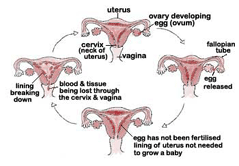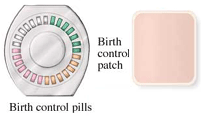If you are a teenage girl, you have probably started having a period already. If you are still waiting for your first menstrual bleeding, you might be anxious about this topic and want to know more about it. Menstrual cycle is quite a complex physiological process in a woman’s body but it is very interesting and important for you to understand.
Menstrual cycle
 What is a menstrual cycle? It is a periodic cycle of certain physiological changes in women’s body. Menstrual cycle is closely associated with female fertility. Reproductive hormones, such as estradiol (estrogen), progesterone, follicle-stimulating hormone and luteinizing hormone, are responsible for recurring changes during this cycle.
What is a menstrual cycle? It is a periodic cycle of certain physiological changes in women’s body. Menstrual cycle is closely associated with female fertility. Reproductive hormones, such as estradiol (estrogen), progesterone, follicle-stimulating hormone and luteinizing hormone, are responsible for recurring changes during this cycle.
Menarche is the first period in a woman’s life. The age of menarche depends on diet, genetics, environment and health status. The average age for the first menstrual bleeding is 12 years worldwide. However, this age ranges from 8 to 16 and is considered normal. Menstrual cycle continues during the whole woman’s reproductive life, the end of which is called menopause , and most commonly starts at the age of 51 years. This is when the menstrual cycle stops occurring and a woman cannot get pregnant anymore.
The length of a woman’s menstrual cycle is very individual – it can be shorter or longer. Normally, less than eight days between the longest cycle and shortest one are allowed to consider the menstrual cycle as normal.
Girls, who have their menstrual cycle for the first time in their life, should learn how to count their cycle. You should start your cycle from the first day of menstrual bleeding. Menstrual cycle is divided into several phases, which differ in physiology and hormones that regulate menstrual cycle.
Menstruation phase
First phase is menstruation. Normally it lasts from 3 to 5 days (but 2-7 days duration is also normal). During this time a woman experiences uterine bleeding of about 35 milliliters and therefore, may require more iron in her diet to avoid iron deficiency. Uterine cramps are also very common during period, and might require the use of some medications to soothe them.
Follicular phase
After menstrual phase is over, follicular or proliferative phase starts under control of the rising follicular-stimulating hormone on the 5th day through 13th day of the menstrual cycle. During this phase, the amount of estrogen increases and, therefore, uterine lining becomes thicker. In addition, due to the action of the follicle-stimulating hormone follicles begins to develop in the ovary, until there is only one of them, called the dominant, left. This dominant follicle continues to grow and soon is able to ovulate, meaning to leave the ovary.
Ovulation phase
Ovulation is the next phase of the menstrual cycle and it is when a mature ovum is released from the ovary to the abdominal cavity. This is due the action of estradiol, which triggers the luteinizing hormone that helps an egg to become mature and weakens the membrane of the follicle, so that a mature ovum could be released. Fallopian tubes must catch this released egg and bring it to the site of fertilization. If a woman has sexual intercourse during ovulation or a few days before or after it, then sperm is able to join the egg, and a woman becomes pregnant. If sperm is not present at the time of ovulation, an egg will not get fertilized and eventually it will dissolve in the uterus.&
During the phase of ovulation, this usually occurs on the 14th day of the menstrual cycle , a woman experiences changes in vaginal discharge, which then becomes profuse, stringy and clear in color. Also, some women may experience a dull pain at the lower part of the abdomen, lasting for a few hours. In addition, some women may have a light mid-cycle bleeding. Scientists say, that at the time of ovulation women have a greater smell ability.
Luteal phase
After the ovulation phase is over, luteal phase starts from the day 15 through 28 of the cycle. Parts of the follicle that are left in the ovary become a so called corpus luteum, that produces large amounts of progesterone. Progesterone is necessary for the uterine lining to proliferate, in order to become more suitable for implantation of a fertilized egg. If an egg is fertilized then it gets implanted in the uterus and corpus luteum continues to produce large amounts of progesterone and, therefore, when a woman becomes pregnant one of the first signs is absence of a period. If an egg does not get fertilized, corpus luteum diminishes in about two weeks and stops secreting progesterone, therefore menstrual bleeding occurs on the 28th day of the menstrual cycle.
During ovulation and luteal phase, the woman’s body temperature rises by one quarter to half a degree Celsius, which is important for women who use temperature method as a natural birth control method.
Duration of the menstrual cycle
The duration of the follicular phase and the menstrual cycle varies. The luteal phase usually lasts the same number of days in the same woman. Its length is from 10 to 16 days depending individually. Sperm is known to be able to survive in a woman’s body from 3 to 8 days. The period when a woman is most fertile, meaning the highest possibility of sexual intercourse to lead to pregnancy, is 5 days before ovulation and 1-2 days after it. There are certain natural methods of birth control that try to detect accurate time of ovulation and determine fertile and infertile days of the menstrual cycle.
It is, however, a mistake to take into account that ovulation always occurs on the day 14 of the menstrual cycle. There are several methods, such as basal body temperature measurements, vaginal discharge observation, observation of the cervical position. And there are also certain detection kits that help women to determine the exact day of ovulation.
However, women should be aware that natural birth control methods have a very low practical efficiency in contraception. And also, a woman must have a regular menstrual cycle in order to use natural birth control method effectively.
There is also a phenomenon known for women, who live closely together, for example, roommates, to have menstrual cycles similar in length. Although this was not 100% proved, it can still be observed, and thought to be due to the action of pheromones.
 The process of losing virginity is explained clearly from the physiological point of view. During the first sexual intercourse the hymen or a membrane is physically torn. A hymen is a part of vulva and it in a way closes the entrance to vagina. Therefore, after the first time penis goes into vagina and membrane is torn woman is considered not a virgin any more. However, the absence of hymen doesn’t necessary mean that women had sex already. It can happen that woman was born without it or the hymen disappeared itself during the lifetime. Women can also loose hymen in the process of exercising or using a tampon. It is also possible the women can have very thick membrane. In this case, she needs surgical cutting or total removal of hymen.
The process of losing virginity is explained clearly from the physiological point of view. During the first sexual intercourse the hymen or a membrane is physically torn. A hymen is a part of vulva and it in a way closes the entrance to vagina. Therefore, after the first time penis goes into vagina and membrane is torn woman is considered not a virgin any more. However, the absence of hymen doesn’t necessary mean that women had sex already. It can happen that woman was born without it or the hymen disappeared itself during the lifetime. Women can also loose hymen in the process of exercising or using a tampon. It is also possible the women can have very thick membrane. In this case, she needs surgical cutting or total removal of hymen.  Sexually transmitted diseases (STD’s) include infections, which are spread through a sexual contact from one person to another. These diseases are a serious problem to people who decide to be sexually active. Statistics shows that there are 15 million of new cases of STD’s are recorded every year in the United States of America. Most of these cases are among the age groups from 15 – 24. Therefore it is very important to understand how to prevent the spread of sexually transmitted diseases and protect against them.
Sexually transmitted diseases (STD’s) include infections, which are spread through a sexual contact from one person to another. These diseases are a serious problem to people who decide to be sexually active. Statistics shows that there are 15 million of new cases of STD’s are recorded every year in the United States of America. Most of these cases are among the age groups from 15 – 24. Therefore it is very important to understand how to prevent the spread of sexually transmitted diseases and protect against them. What is a menstrual cycle? It is a periodic cycle of certain physiological changes in women’s body. Menstrual cycle is closely associated with female fertility. Reproductive hormones, such as estradiol (estrogen), progesterone, follicle-stimulating hormone and luteinizing hormone, are responsible for recurring changes during this cycle.
What is a menstrual cycle? It is a periodic cycle of certain physiological changes in women’s body. Menstrual cycle is closely associated with female fertility. Reproductive hormones, such as estradiol (estrogen), progesterone, follicle-stimulating hormone and luteinizing hormone, are responsible for recurring changes during this cycle. The
The  Sometimes it happens that women forget to take a
Sometimes it happens that women forget to take a  As it was mentioned before, the symptoms are very similar to those that women have. However, the difference is that not all the men experience it. Only 40 % out of all men that are between 40 and 60 will suffer for stress, depression, mood swing, irritability, sleep disturbances, reduced libido and potency. Even 51 % of healthy man can experience certain degree of impotence. Age is not the problem – 40 % of man can perform normal erection up to 70 years or more. It can happen by combination of other diseases. Total impotence and sexual frustration can become a problem because of the lack of understanding of the partner.
As it was mentioned before, the symptoms are very similar to those that women have. However, the difference is that not all the men experience it. Only 40 % out of all men that are between 40 and 60 will suffer for stress, depression, mood swing, irritability, sleep disturbances, reduced libido and potency. Even 51 % of healthy man can experience certain degree of impotence. Age is not the problem – 40 % of man can perform normal erection up to 70 years or more. It can happen by combination of other diseases. Total impotence and sexual frustration can become a problem because of the lack of understanding of the partner.  Throughout many years people tried to find ways to control fertility and prevent pregnancies. Even though in the earliest times people had little or no idea how women became pregnant, there were many mechanisms and various
Throughout many years people tried to find ways to control fertility and prevent pregnancies. Even though in the earliest times people had little or no idea how women became pregnant, there were many mechanisms and various